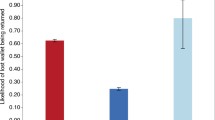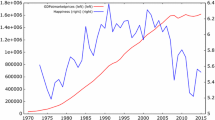Abstract
Can a society’s overall level of happiness change? Until recently, it was widely held that happiness fluctuates around set-points, so that neither individuals nor societies can lastingly increase their happiness. However, data from surveys carried out in Russia from 1982 to 2011 show that happiness fell substantially following the collapse of the Soviet Union, and has begun to rise again only recently. Additional data sources, including suicide rates and indices of negative affect expression, confirm these shifts. Contrary to set-point theory, we find that the recent increase has been driven as much by generational replacement as by mean reversion among individuals. The collapse of communism led to a permanent drop in subjective wellbeing among mid-life cohorts that was subsequently never fully recovered. Happiness can be substantially and permanently impacted by life-events, including those affecting society as a whole, and societal-level happiness can rise or fall over time as a result.





Similar content being viewed by others
Notes
Data for the 1990, 1995, 2006 and 2011 surveys are available in the aggregate WVS file at www.worldvaluessurvey.org, while data for the 1999 survey is included in the European Values Study aggregate file (http://www.europeanvaluesstudy.eu/page/survey-1999.html).
One proxy for subjective affect can be gleaned from frequency of word citation (Michel et al. 2011). The most common method of doing so is via the “n-gram” a contiguous sequence of n items from a given sequence of text or speech, which can be phonemes, syllables, letters, words or base pairs. The n-gram model is a type of probabilistic language model for predicting the next item in such a sequence in the form of a Markov model, and such models are now widely used in probability, communication theory, computational linguistics, computational biology, and data compression. We use the Russian language search of the Google Ngram database, which covers all books predominantly in the Russian language; for the period under consideration, these are overwhelmingly soviet publications (Google 2010). The coverage of this database is exceptionally broad; within the English language corpus, for example, are as many as 4% of all published English language texts over the past two centuries. The results are normalised by the number of texts published in each year, thereby ensuring results are indicative of relative frequency and not affected by the obvious increase in publication material over time.
The subjective wellbeing index is calculated by rescaling both the life satisfaction score (1–10) and the happiness response (1–4) to a 0–10 range, and then averaging across the two measures, providing a combined 0–10 index of subjective wellbeing.
References
Acerbi, A., Lampos, V., Garnett, P., & Bentley, R. A. (2013). The expression of emotions in 20th century books. PLoS ONE, 8(3), e59030. doi:10.1371/journal.pone.0059030.
Aldrich, J. H., Taylor, A., & Wood, W. (2007). Repeated turnout as a habit. Paper presented at the 65th annual meeting of the midwest political science association. Chicago, IL, April 12–15.
Antman, F., & McKenzie, D. (2007). Earnings mobility and measurement error: a pseudo-panel approach. Economic Development and Cultural Change, 56(1), 125–161.
Blanchflower, D., & Oswald, A. (2004). Well-being over time in Britain and the USA. Journal of Public Economics, 88(7), 1359–1386.
Bourguignon, F., Goh, C., & Kim, D. (2004). Estimating individual vulnerability to poverty with pseudo-panel data. World Bank policy research working paper no. 3375.
Bray, I., & Gunnell, D. (2006). Suicide rates, life satisfaction and happiness as markers for population mental health. Social Psychiatry and Psychiatric Epidemiology, 41(5), 333–337.
Brickman, P., & Campbell, D. T. (1981). Hedonic relativism and planning the good society. In M. Appley (Ed.), Adaptation-level theory (pp. 287–305). New York: Academic Press.
Brickman, P., Coates, D., & Janoff-Bulman, R. (1978). Lottery winners and accident victims: Is happiness relative? Journal of Personality and Social Psychology, 36(8), 917–927.
Clark, A., Frijters, P., & Shields, M. (2008). Relative income, happiness, and utility: An explanation for the Easterlin paradox and other puzzles. Journal of Economic Literature, 46(1), 95–144.
Daly, M. C., & Wilson, D. J. (2009). Happiness, unhappiness, and suicide: An empirical assessment. Journal of the European Economic Association, 7(2–3), 539–549.
Danner, D., Snowdon, D., & Friesen, W. V. (2012). Positive emotions in early life and longevity: Findings from the nun study. Journal of Personality and Social Psychology, 80(5), 804–813.
Delle Fave, A. (2014). Well-being in times of crisis: Interdisciplinary evidence and policy implications. Journal of Happiness Studies, 15(1), 119–123.
Denzin, N. (2006). Sociological methods: A sourcebook. Aldine Transaction: Piscataway.
Diener, E., Diener, M., & Diener, C. (1995). Factors predicting the subjective well-being of nations. Journal of Personality and Social Psychology, 69, 851–864.
Diener, E., Lucas, R. E., & Scollon, C. N. (2006). Beyond the hedonic treadmill: Revising the adaptation theory of well-being. American Psychologist, 61, 305–314.
Diener, E., & Oishi, S. (2000). Money and happiness: Income and subjective well-being across nations. In E. Diener & E. Suh (Eds.), Subjective well-being across cultures. Cambridge: MIT Press.
Diener, E., Suh, E., Lucas, E., & Smith, H. (1999). Subjective well-being: Three decades of progress. Psychological Bulletin, 125, 276–302.
Easterlin, R. A. (1974). Does economic growth improve the human lot? In P. A. David & M. Reder (Eds.), Nations, households and economic growth (pp. 98–125). New York: Academic Press.
Easterlin, R. A. (2003). Explaining happiness. Proceedings of the National Academy of Sciences, 100(19), 11176–11183.
Easterlin, R. A. (2005a). Feeding the illusion of growth and happiness: A reply to Hagerty and Veenhoven. Social Indicators Research, 75, 429–443.
Easterlin, R. A. (2005b). Feeding the illusion of growth and happiness: A reply to Hagerty and Veenhoven. Social Indicators Research, 74, 429–443.
Easterlin, R. A., Morgan, R., Switek, M., & Wang, F. (2012). China’s life satisfaction, 1990–2012. Proceedings of the National Academy of Sciences, 109(25), 9775–9780.
Fowler, J. H. (2006). Habitual voting and behavioral turnout. The Journal of Politics, 68(2), 335–344.
Frederick, S., & Loewenstein, G. (1999). Hedonic adaption. In D. Kahneman, E. Diener, & N. Schwarz (Eds.), Well-being: Foundations of hedonic psychology. New York, NY: Russell Sage Foundation.
Froh, J., Sefick, W., & Emmons, R. A. (2006). Counting blessings in early adolescents: An experimental study of gratitude and subjective well-being. Journal of School Psychology, 46(2008), 213–233.
Fujita, F., & Diener, E. (2005). Life satisfaction set point: Stability and change. Journal of Personality and Social Psychology, 85, 155–164.
Gerber, A. S., Green, D. P., & Shachar, R. (2003). Voting may be habit-forming: Evidence from a randomized field experiment. American Journal of Political Science, 47(3), 540–550.
Google. (2010). The Google books Ngram viewer. https://books.google.com/ngrams.
Goscomstat. (1981–1990). Statistical yearbook of the Soviet Union. Moscow: Goscomstat.
Halvorsen, K. (2016). Economic, financial, and political crisis and well-being in the PIGS-countries. Sage Open. doi:10.1177/2158244016675198.
Helliwell, L. (2007). Well-being and social capital: Does suicide pose a puzzle? Social Indicators Research, 81(3), 455–496.
Inglehart, R. (1990). Culture shift in advanced industrial society. Princeton: Princeton University Press.
Inglehart, R. (1997). Modernization and postmodernization: Cultural, cconomic and political change in 43 societies. Princeton: Princeton University Press.
Inglehart, R., Foa, R. S., Welzel, C., & Peterson, C. (2008). Development, freedom, and rising happiness: A global perspective, 1981–2007. Perspectives on Psychological Science, 3(4).
International Labor Organization. (2012). Laborstat. http://laborsta.ilo.org/.
Kahneman, D., & Krueger, A. B. (2006). Developments in the measurement of subjective well-being. Journal of Economic Perspectives, 20, 3–24.
Kahneman, D., Krueger, A. B., Schkade, D. A., Schwartz, N., & Stone, A. A. (2004). A survey method for characterizing daily life experience: The day reconstruction method. Science, 3, 1776–1780.
Kenny, C. (2004). Does development make you happy? Subjective wellbeing and economic growth in developing countries. Social Indicators Research, 65, 1–22.
Koivumaa-Honkanen, H., Honkanen, R., Viinamäki, H., Heikkilä, K., Kaprio, J., & Koskenvuo, M. (2001). Life satisfaction and suicide: a 20-year follow-up study. American Journal of Psychiatry, 158(3), 433–439.
Lanjouw, P., Dang, H., Luoto, J., & McKenzie. D. (2011). Using repeated cross-sections to explore movements in and out of poverty. Development economics research group policy research working paper 5550. Washington, DC: World Bank.
Lucas, R. E., Clark, A. E., Georgellis, Y., & Diener, E. (2003). Reexamining adaptation and the set point model of happiness: Reactions to changes in marital status. Journal of Personality and Social Psychology, 84, 527–539.
Michel, J. B., Shen, Y. K., Aiden, A. P., Veres, A., Gray, M. K., Brockman, W., et al. (2011). Quantitative analysis of culture using millions of digitized books. Science, 331(6014), 176–182.
Raleigh, D. (2006). Russia’s Sputnik generation: Soviet baby boomers talk about their lives. Bloomington, IN: Indiana University Press.
Sen, A. (2001). Development as freedom. New York: Alfred Knopf.
Smith, T. W. (1986). Unhappiness on the 1985 GSS, GSS methodological report. New york, CH: NORC.
Stevenson, B., & Wolfers, J. (2013). Subjective well-being and income: Is there any evidence of satiation? American Economic Review, American Economic Association, 103(3), 598–604.
Tilley, J. (2002). Political generations and partisanship in the UK, 1964–1997. Journal of the Royal Statistical Society. Series A (Statistics in Society), 165(1), 121–135.
Tilley, J. (2003). Party identification in Britain: Does length of time in the electorate affect strength of partisanship? British Journal of Political Science, 33(2), 332–344.
Veenhoven, R. (2012). World database of happiness. www1.eur.nl/fsw/happiness/.
Veenhoven, R., & Hagerty, M. (2006). Rising happiness in nations, 1946–2004. Social Indicators Research, 79, 421–436.
Watkins, P., Woodward, K., Stone, T., & Kolts, R. L. (2003). Gratitude and happiness: Development of a measure of gratitude, and relationships with subjective wellbeing. Social Behavior and Personality, 31(5), 431–452.
World Bank. (2012). World development indicators. http://data.worldbank.org/data-catalog/world-development-indicators.
World Values Survey. (2014). Longitudinal aggregate data file, World Values Survey Association. Aggregate File Producer: JDSystems, Madrid. www.worldvaluessurvey.org.
Zubkova, E. (1998). Russia after the war: Hopes, illusions, and disappointments. 1945–1957 (R. Hugh Trans.) Armounk, NY: M.E. Sharpe.
Acknowledgements
Financial support from the U.S. National Science Foundation and from the Government of the Russian Federation within the 5-100 program roadmap of the National Research University, Higher School of Economics is gratefully acknowledged.
Author information
Authors and Affiliations
Corresponding author
Rights and permissions
About this article
Cite this article
Foa, R.S., Inglehart, R., Ponarin, E. et al. Set-Point Theory and Societal Collapse: The Case of Russia. J Happiness Stud 19, 1639–1656 (2018). https://doi.org/10.1007/s10902-017-9888-4
Published:
Issue Date:
DOI: https://doi.org/10.1007/s10902-017-9888-4




